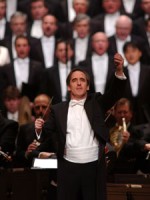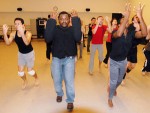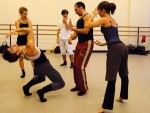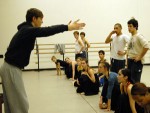Title
Subhead
As James Conlon makes his way through the Juilliard hallways, every few steps someone greets him warmly, saying, “Hello, Maestro.” Nearly 40 years after he first navigated these hallways as a freshman, the internationally acclaimed conductor has returned to initiate an ambitious, wide-ranging two-year residency that reflects the impassioned commitment that has marked his exemplary career. Beginning with this month’s dance performances, Conlon will conduct programs involving all three divisions, while also devoting time to coaching, leading master classes, and participating in symposia.
Robert Battle, one of the three choreographers commissioned to set works by Recovered Voices composers for the 2007 December Dance Creations, working with the fourth-year class.
(Photo by Nan Melville)Nicolo Fonte, one of the three choreographers commissioned to set works by Recovered Voices composers for the 2007 December Dance Creations, working on third-year dancers.
(Photo by Nan Melville)Adam Hougland, one of the three choreographers commissioned to set works by Recovered Voices composers for the 2007 December Dance Creations, working with the second-year dancers.
(Photo by Nan Melville)Body
In the course of these varied activities, Conlon will focus on aspects of classical music, and concerns about its place in contemporary society, that have been of paramount concern to him and are reflected in many of his recent projects. A major focus of the residency will be the music of composers whose careers were cut short, and reputations severely diminished, by the Nazi regime and its classification of their work as “degenerate art.” Conlon has been enthusiastically championing their scores for the past 15 years, often programming them when he guest-conducts and, in his role as music director of Los Angeles Opera and the Ravinia Festival, designing ongoing projects to bring their music to new audiences. At Juilliard, Conlon’s residency will also examine the classical artist’s relationship to, and role within, contemporary society.
Shortly after a week of conducting the New York Philharmonic, which followed his performances of Fidelio and Jenufa in Los Angeles, Conlon, 57, settled into a Juilliard conference room and spoke with fervor about what he intends to explore over the next two years. “The big subject is, what happens when classical art clashes with the society in which it finds itself? I’m going to use the events of the 1930s and ‘40s in Europe—specifically Germany, but we will have programs where we can compare it with Paris, which was outside the influence of the Third Reich, for a long time. We’re going to look at that period and see what happens when something gets lost. Can it be refound, resuscitated, 50 or 70 years after that fact? Then the questions that flow from that are: you can’t second-guess history, but what might have happened if—and what were the currents that were alive that might have altered the history of classical music had they not been uprooted? Why have we arrived at certain conclusions about the 20th century, about who was important and who had the most influence—whereas it might have been quite different. We’re going to look at all of those questions. I don’t know if we’ll have answers.”
An additional topic to be explored is classical music’s relationship to our own society, says Conlon—the factors that are influencing its production and appreciation, and the vibrancy of the classical tradition. “How is society affecting that? Are we affecting society? Are we just a very small cocoon that is trying to survive? What happens when there are factors in society that actively clash with the nourishing of this tradition?”
Conlon recalls that when Joseph W. Polisi, Juilliard’s president, approached him about the residency, he said, “I want to have you come here and take an idea and run with it. Tell me what you might want to do.” Conlon’s response: “I want to work with every department, because I don’t want it to be narrow. I want it to be broad—it’s about the arts, all of us. It’s also a reminder (and I know Joseph is very strong on this) that students are not here just to learn how to play their instruments, or dance, or act. They’re also here to realize that artists have a role in society. Society needs them—even if society doesn’t know it needs them. That consciousness needs to be raised, at the time of being a student.”
Conlon’s undergraduate years (1968 to 1972) overlapped with the height of antiwar protesting at many universities and increased political activism throughout the country. “During my years as a Juilliard student, I would say the one thing lacking was that approach to seeing whatever we were studying as very important in itself, but also important in a greater context. I was a student here at a time of ferment; in some ways, there was a greater context imposed on us. There were a lot of us who were active and thoughtful on that subject—not enough, as far as I was concerned. Now, it is a conservatory, and I completely agree that you’ve got to devote those years to mastering your instrument. But I think Joseph [Polisi] has done a great job of changing a lot about the School from what I remember from when I entered, and I want to participate in that.”
Conlon—who during his senior year stepped in when a major conductor became unavailable to conduct a 1972 Juilliard La Bohème production, and who even before graduating had conducted Boris Godunov at Italy’s famed Spoleto Festival—has had a career divided more or less equally between Europe and America. From 1983 to 2004, he was based in Europe, serving as music director of the Rotterdam Philharmonic, the Cologne Opera, and the Paris Opera. Since 2004, the native New Yorker has been based here, though still traveling all over for his multifaceted engagements.
His passionate interest in the composers silenced by the Nazi regime has led to many performances and recordings for which he has conducted major scores that had languished unheard for decades, in the process awakening audiences to their high caliber and significant connections to other music of their time. At the Los Angeles Opera, he has initiated the Recovered Voices project, scheduling a production each season—this year, it will be a double bill of works by Alexander Zemlinsky and Viktor Ullmann. His recent New York Philharmonic program featured the orchestra’s first performances of Zemlinsky’s A Florentine Tragedy, a powerful one-act opera based on an Oscar Wilde play.
It was Zemlinsky (1871-1942) who launched Conlon’s abiding (and now influential) interest in this group of composers. During his Cologne tenure, he heard one of the composer’s scores on the radio and became entranced. He had been familiar with the name of this major musical figure whose students included Schoenberg (who became his brother-in-law), Berg, Webern, and Korngold—but not his music. “One day you discover that there’s a real person, real music, behind the name. That real music is beautiful, interesting, and thrilling,” he says. Soon he was recording one Zemlinsky composition after another for EMI, and learning about additional important composers whose output had been banned—and denied its place in musical history—because of the Nazis’ intolerance. “I love this music, it stimulates me, and I have also found that I will go back to it over and over, which means I’m able to perform it in a committed way.
"Most of it is there on paper (some has been lost, but a great deal is there), but isn’t performed," continues Conlon. "Classical music really enters civilization when it is heard and experienced by people, and people react to it—discuss it, then hear it again, new interpretation—that’s how classical music regenerates. That was completely impossible for those banned composers. We’re not just talking about music written between 1933 and 1945. It was retroactive. Most of them were Jewish; every Jewish composer was banned—including Mendelssohn. Because the music wasn’t heard, it has remained under the radar—certainly in this country—for 60 years. In Germany, there was a real attempt to take consciousness of this during the 1970s.”
The three choreographers creating new works for December Dance Creations are setting them to scores selected from the "Recovered Voices" group. Conlon suggested possible compositions to Lawrence Rhodes, artistic director of the Dance Division, who then presented options to the choreographers and matched them up with scores. “When people see choreography and hear the music—they take in that music in a very special way. I think it’s a very powerful way to get these composers to be able to speak to our audiences,” Conlon observes. “I want to find every possible avenue through which this music will be heard and live.”
Adam Hougland, a Juilliard alumnus, has choreographed to Franz Schreker’s Prelude to a Drama: Die Gezeichneten, an expansion of what began as an overture to the 1918 opera, whose title translates as “The Stigmatized.” “It’s almost a symphonic poem, with very evocative and original orchestration,” says Conlon, who in 2010 will conduct the opera’s first-ever U.S. production in Los Angeles. “It’s not meant to be played before the opera, which is an extremely intricate psychodrama set in Renaissance Italy, but to stand by itself.” Schreker (1878-1934) was one of the most highly regarded operatic composers of his time, as well as director of Berlin’s Music Academy.
Hougland did not refer to the opera’s libretto, but instead listened extensively to the score. “I find it very atmospheric and moody—almost dreamlike,” he says. “It reminded me of watching birds in flight, in the clouds—that was my first image. I found it intriguing to think about the idea of uncovering voices. The piece itself has that feel. It starts out very formal, the dancers moving as one giant, faceless mass. As the piece goes on, I deviate from that and let individuals emerge. It’s not often you have a chance to create for such a large group of dancers, and I wanted to play with ways of moving the whole group like one giant organism.”
Nicolo Fonte is choreographing to Zemlinsky’s 1934 Sinfonietta, the composer’s last major orchestral work, and his only piece to be performed in this country—by the New York Philharmonic, Dmitri Mitropoulos conducting—during the brief time he lived in New York, following his escape from the Nazis. “I immediately loved the Sinfonietta, for its danceability factor," says Fonte. “It was angular in places, then very lush and lyrical in others. That’s what I connected to immediately. The Adagio is gorgeous—really mysterious and lush. The first movement, Presto, is thrilling music. It gives me images of people flying in the air. The dance, on some level, deals with the idea of bursting free, of a kind of ultimate freedom. I hear that in the score—this desire to free oneself from constrictions.”
Ogelala, the 1925 Erwin Schulhoff score that Juilliard alumnus Robert Battle is choreographing, is the one composition that was originally written for dance, making it a natural choice for this program. The Czech composer, born in 1894, died of tuberculosis in the Wülzburg concentration camp in 1942. “I consider Schulhoff one of the most interesting avant-garde composers of that period. notes Conlon, who conducted the score’s U.S. premiere last year in Aspen. He wrote Dadaist music, and was one of the first composers to integrate jazz—before Gershwin, before Milhaud. This work, to me, is an extraordinary piece of vital, rhythmic music.”
Battle did some research into the original ballet’s scenario, which dealt with a pre-Colombian Mexican warrior, but says, “I really didn’t connect much to the story; I connected more to the music. I thought it was rhythmically and dramatically the kind of orchestral music I like. You find so many influences and colors in the score. After I said yes, fear was the overwhelming reaction—this music is so difficult. It’s over 30 minutes, and that’s a condensed version. The rhythmic elements are quite genius. It must be changing meters and time signatures all the time. I feel like I have this silent partner in this choreography that is Erwin Schulhoff. I certainly feel his presence in the score.”
Conlon’s multifaceted residency includes three chamber concerts in April, “Generate and Degenerate Music,” presenting in chronological order works created between 1916 and 1931, offering an opportunity to contrast those by Paris-based composers and those whom the Nazis silenced. A forum in conjunction with the concerts will examine these musicians’ contrasting lives and fates. And next November, Conlon will conduct a trilogy of one-act operas by Mussorgsky, Ernst Krenek, and Veniamin Fleischmann.
As he outlines his hopes and expectations for his residency, Conlon not only conveys the fascinating possibilities of re-evaluating a neglected group of composers, but also touches on issues of censorship, the possibilities and dangers offered by new technology, and concerns about present-day educational priorities. Clearly, this former student’s return will enliven Juilliard’s next two years with a great many stimulating musical events and discussions.








